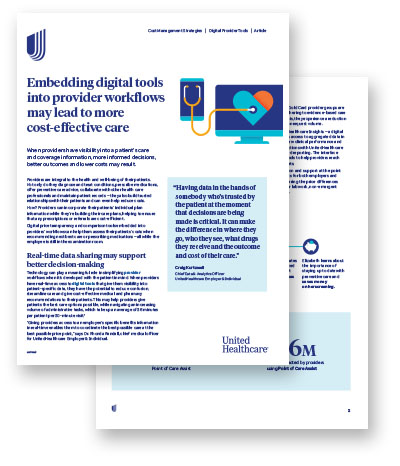Embedding digital tools into provider workflows may lead to more cost-effective care
When providers have visibility into a patient’s care and coverage information, more informed decisions, better outcomes and lower costs may result.
Providers are integral to the health and well-being of their patients. Not only do they diagnose and treat conditions, prescribe medications, offer preventive care advice, collaborate with other health care professionals and maintain patient records — they also build trusted relationships with their patients and can even help reduce costs.
How? Providers can incorporate their patients’ individual plan information while they’re building their care plans, helping to ensure that any prescriptions or referrals are cost-efficient.
Digital price transparency and comparison tools embedded into providers’ workflows can help them assess their patients’ costs when recommending next best care or prescribing medications—all while the employee is still in the examination room.
Real-time data sharing may support better decision-making
Technology can play a meaningful role in simplifying provider workflows when it’s developed with the patient in mind. When providers have real-time access to digital tools that give them visibility into patient-specific data, they have the potential to reduce confusion, streamline care and give cost-effective medical and pharmacy recommendations to their patients. This may help providers give patients the best care options possible, while navigating an increasing volume of administrative tasks, which take up an average of 36 minutes per patient per 30-minute visit.1
“Giving providers access to an employee’s specific benefits information in real-time enables them to coordinate the best possible care at the best possible price point,” says Dr. Rhonda Randall, chief medical officer for UnitedHealthcare Employer & Individual.
At the point of care
Health care price of care tools can be a valuable resource for providers seeking to extend quality care at affordable costs to their patients. These tools present information about the costs of health care services, giving providers the ability to make more cost-effective decisions about their patients’ care.
Point of Care Assist® is a platform that integrates an employee’s benefit information with a provider’s electronic medical records (EMRs), offering up-to-date insights into clinical, pharmacy, lab and cost data.
Point of Care Assist also works to help reduce providers’ administrative burden by making it easier to check everything from prior authorization and referral requirements to patient eligibility — all while patients are still in the examination room. This transparency may help improve quality of care and health outcomes for employees, leading to higher satisfaction levels.
The Gold Card program is another way UnitedHealthcare is working to streamline and modernize the prior authorization process for providers, helping their patients receive quicker access to the care they need. Gold Card provider groups are recognized for consistently adhering to evidence-based care guidelines — and because of this, they experience a reduction in their total prior authorization request volume.
When combined with UnitedHealthcare Insights — a digital interface providing end-users access to aggregated data in real time — providers can review clinical performance and provider-level channel interactions with UnitedHealthcare for simplified and personalized reporting. The interface also includes trend analysis tools to help providers reach affordability and quality targets.
Solutions that offer information and support at the point of care may lead to lower costs for both employers and employees, especially considering the price differences across various sites of care for lab work, non-emergent surgeries and radiology scans.
Supporting decisions with real-time information
- Elizabeth has an annual visit with her primary care provider, Dr. Smith. They discuss her need for a colorectal screening.
- Dr. Smith uses the quick lookup feature to determine that the screening does not require a prior authorization.
- Elizabeth’s health plan requires a referral to a gastroenterologist at an ambulatory surgery center.
- Dr. Smith easily locates a provider recognized for quality and cost efficiency and makes the referral.
- Elizabeth learns about the importance of staying up to date with preventive care and saves money on her screening.
Member profiles and scenarios are fictional. Health outcomes are not guaranteed.
At the point of prescribing
Another area where providers can proactively help manage employee and employer costs is at the point of prescribing. Tools that allow physicians access to patient specific pharmacy information may improve affordability, medication adherence and health outcomes.
For instance, PreCheck MyScript®, a real-time benefits data tool from Optum Rx®, helps providers access prescription costs, prior authorization requirements and patient coverage details directly through their EMR platform. This convenient access to patient data may help providers focus more on patient care, while enabling patients to get medications faster.
When a provider prescribes a medication through PreCheck MyScript, a trial claim is run through the Optum Rx pharmacy claims data base. Providers are given the employees’ coverage status, medication options and information about whether alternatives are available. It also lists the cost to employees based on their specific health plan, deductibles and out-of-pocket obligations — information that is critical in helping employees make.
PreCheck MyScript by the numbers3
- 13% of prescriptions with alternatives presented resulted in a script change
- $119 average savings for members per prescription fill when prescribers selected the lower-cost alternative medication
- $266 average savings for employers per switch to a lower-cost drug alternative
